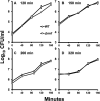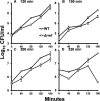Absence of Ribosome Modulation Factor Alters Growth and Competitive Fitness of Escherichia coli
- PMID: 35377189
- PMCID: PMC9045171
- DOI: 10.1128/spectrum.02239-21
Absence of Ribosome Modulation Factor Alters Growth and Competitive Fitness of Escherichia coli
Abstract
During stationary phase in Escherichia coli, the expression of the ribosome modulation factor (RMF) protein participates in the dimerization of two 70S ribosomes, ultimately creating a 100S particle. 100S ribosomes are commonly thought to function to preserve ribosomes as growth ceases and cells begin to catabolize intracellular components, including proteins, during their transition into stationary phase. Here, we show that the rates of stationary-phase ribosomal degradation are increased in an rmf mutant strain that cannot produce 100S ribosomes, resulting in deficiencies in outgrowth upon reinoculation into fresh medium. Upon coinoculation in LB medium, the mutant exhibits a delay in entry into log phase, differences in growth rates, and an overall reduction in relative fitness during competition. Unexpectedly, the rmf mutant exhibited shorter generation times than wild-type cells during log phase, both in monoculture and during competition. These doubling times of ∼13 min suggest that failure to maintain ribosomal balance affects the control of cell division. Though the timing of entry into and exit from log phase is altered, 100S ribosomes are not essential for long-term viability of the rmf mutant when grown in monoculture. IMPORTANCE Ribosomes are the sole source in any cell for new protein synthesis that is vital to maintain life. While ribosomes are frequently consumed as sources of nutrients under low-nutrient conditions, some ribosomes appear to be preserved for later use. The failure to maintain the availability of these ribosomes can lead to a dire consequence upon the influx of new nutrients, as cells are unable to efficiently replenish their metabolic machinery. It is important to study the repercussions, consequences, and mechanisms of survival in cells that cannot properly maintain the availability of their ribosomes in order to better understand their mechanisms of survival during competition under nutrient-depleted conditions.
Keywords: 100S ribosome; competitive fitness; long-term survival; ribosome modulating factor.
Conflict of interest statement
The authors declare no conflict of interest.
Figures





Similar articles
-
The ribosome modulation factor (RMF) binding site on the 100S ribosome of Escherichia coli.J Biochem. 2002 Dec;132(6):983-9. doi: 10.1093/oxfordjournals.jbchem.a003313. J Biochem. 2002. PMID: 12473202
-
Activities of Escherichia coli ribosomes in IF3 and RMF change to prepare 100S ribosome formation on entering the stationary growth phase.Genes Cells. 2009 Feb;14(2):271-80. doi: 10.1111/j.1365-2443.2008.01272.x. Epub 2008 Jan 15. Genes Cells. 2009. PMID: 19170772
-
Modulation of mRNA stability participates in stationary-phase-specific expression of ribosome modulation factor.J Bacteriol. 2005 Mar;187(6):1951-8. doi: 10.1128/JB.187.6.1951-1958.2005. J Bacteriol. 2005. PMID: 15743942 Free PMC article.
-
Growth phase coupled modulation of Escherichia coli ribosomes.Genes Cells. 1998 Apr;3(4):203-8. doi: 10.1046/j.1365-2443.1998.00187.x. Genes Cells. 1998. PMID: 9663655 Review.
-
Ribosome Hibernation.Annu Rev Genet. 2018 Nov 23;52:321-348. doi: 10.1146/annurev-genet-120215-035130. Annu Rev Genet. 2018. PMID: 30476446 Review.
Cited by
-
Physiology, fast and slow: bacterial response to variable resource stoichiometry and dilution rate.mSystems. 2024 Aug 20;9(8):e0077024. doi: 10.1128/msystems.00770-24. Epub 2024 Jul 9. mSystems. 2024. PMID: 38980051 Free PMC article.
-
Quorum-Sensing C12-HSL Drives Antibiotic Resistance Plasmid Transfer via Membrane Remodeling, Oxidative Stress, and RpoS-RMF Crosstalk.Microorganisms. 2025 Aug 6;13(8):1837. doi: 10.3390/microorganisms13081837. Microorganisms. 2025. PMID: 40871341 Free PMC article.
-
A new family of bacterial ribosome hibernation factors.Nature. 2024 Feb;626(8001):1125-1132. doi: 10.1038/s41586-024-07041-8. Epub 2024 Feb 14. Nature. 2024. PMID: 38355796 Free PMC article.
-
Physiological stress drives the emergence of a Salmonella subpopulation through ribosomal RNA regulation.Curr Biol. 2023 Nov 20;33(22):4880-4892.e14. doi: 10.1016/j.cub.2023.09.064. Epub 2023 Oct 24. Curr Biol. 2023. PMID: 37879333 Free PMC article.
-
Ribosomal Hibernation Factor Links Quorum-Sensing to Acid Resistance in EHEC.Microorganisms. 2025 Jul 24;13(8):1730. doi: 10.3390/microorganisms13081730. Microorganisms. 2025. PMID: 40871233 Free PMC article.
References
Publication types
MeSH terms
Substances
LinkOut - more resources
Full Text Sources
Molecular Biology Databases

